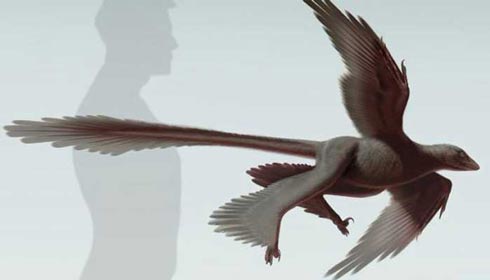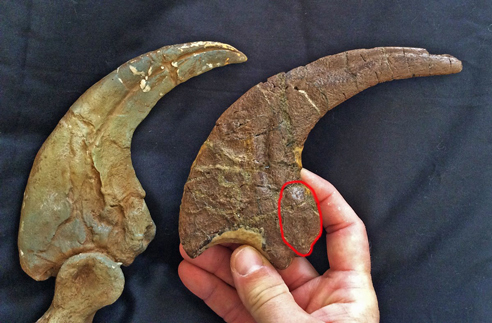Dakotaraptor Compared to Utahraptor – Remarkable Dromaeosaurids
Dakotaraptor Compared to Utahraptor
The vast majority of the dromaeosaurids known were actually rather small when compared to other types of theropod dinosaur. As a group, these active dinosaurs were geographically widespread with fossil specimens found in Asia, both North and South America and even England (Nuthetes destructor). All species described to date were predatory and they certainly seemed to have been amongst the most adaptable of all the Theropoda.
Over the last few years our view of these feathered terrors has changed. They are no longer confined to the role of swift cursorial (running) hunters, scientists have proposed that many members of the Dromaeosauridae were excellent climbers (scansorial), tree dwellers (arboreal) and that a number of them were volant (capable of powered flight or gliding).
Dromaeosaurids like Changyuraptor Seemed to have Filled a Variety of Ecological Niches
Picture credit: S. Abramowicz
The illustration above depicts the dromaeosaurid Changyuraptor yangi from Liaoning Province (China), it was very probably capable of flight.
Dakotaraptor compared to Utahraptor
Over the dromaeosaurids long evolutionary history, gigantic forms did evolve and we suspect that Cretaceous-aged strata still hold the undiscovered remains of a number of super-sized dromaeosaurids. With the naming and describing of Dakotaraptor (D. steini), the Hell Creek Formation can now boast a gigantic sized raptor amongst its faunal members. At around five and a half metres in length Dakotaraptor was a sizeable beast, but for the moment, the dinosaur called Utahraptor (U. ostrummaysorum) which roamed what was to become the State of Utah more than fifty million years before Dakotaraptor evolved, is regarded as the largest.
Direct comparisons are difficult, the two individuals that represent Dakotaraptor (a gracile form and a more robust specimen) are known from only fragmentary remains, limb bones, vertebrae including caudal vertebrae, for example. The holotype of Utahraptor is also fragmentary, consisting of some cranial material, a tibia and caudal vertebrae. Some further fossil material assigned to Utahraptor has come to light since Utahraptor ostrummaysorum was formally named and described, but even so, direct comparisons between these two North American giants is difficult.
Comparing Claws
Ironically, there is one part of these two dinosaurs that we can compare and contrast. The famous sickle-toe killing claw, what is termed the pedal ungual II.
The Sickle-Toe Claws of Utahraptor and Dakotaraptor Compared
Picture credit: Robert DePalma with additional annotation by Everything Dinosaur
In the photograph above, a cast of the second toe claw of Utahraptor (left) is compared to that of Dakotaraptor (right). The claws are very similar in size, although the degree of curvature is different. In addition, Dakotaraptor had a more pronounced flexor tubercle (the ringed area in the photograph). This would suggest that the second toe claw of Dakotaraptor was highly mobile dorsoventrally (it could be moved up and down really well). This might indicate that Dakotaraptor, already nick-named D-raptor, was more capable of slashing with its second toe and with some considerable force too.
When the proposed femur to tibia bone ratios are compared between Utahraptor and Dakotaraptor, it can be seen that D. steini had body proportions very similar to the much smaller dromaeosaurids such as Dromaeosaurus. Utahraptor’s hind legs seem to have been more robust and as a result Utahraptor may have been a heavier animal, but in a sprint Dakotaraptor probably had the edge. Both dinosaurs could very probably outrun even the most talented athlete.
The presence of this new predator expands the record of theropod diversity in Late Cretaceous Laramidia, adding a new dimension to the ecology and food chains that likely occurred in North America towards the end of the Mesozoic.
Why Dakotaraptor steini?
The genus name translates as “robber or thief from Dakota”, whereas the trivial name honours American palaeontologist Walter W. Stein.
CollectA have introduced a large number of feathered dinosaurs including Utahraptor, Velociraptor and Microraptor: CollectA Prehistoric World Models.



